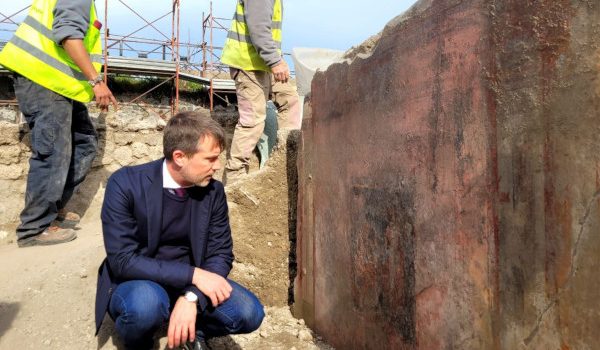New excavations in Regio IX
Pictured here are the new excavations in Regio IX, a previously unexplored area; this is part of the project to protect and maintain the archaeological site. New skeletons from the 79CE eruption are emerging. New investigations were launched in February to explore Regio IX of Pompei - one of the nine districts that the site is divided into - an area that covers approximately 3200mq, almost an entire block of the ancient city that was buried in 79CE by Mount Vesuvius. This project is part of a wider approach, which has been developed in recent years, during the Great Pompei Project, which aims to rectify and resolve hydrological and conservation problems in excavations – for example the boundary between an excavated section and the unexplored ancient city. The latter amounts to around 22 acres of blocks and houses that are still buried underneath lapilli and ash, amounting to almost a third of the ancient settlement.
The layout of the new excavations, located in Insula 10 of Regio IX, along Via di Nola, follows the excavation patterns of Regio V, explored between 2018-2020, under the direction of the then Director Massimo Osanna; this saw the emergence of the Casa di Orione, Casa con Giardino e il Thermopolium (garden and shop where hot food was sold). In addition to improving the conditions of conservation and protection of the millenary structures, by rearranging the excavation fronts, (which have always been an area of vulnerability thanks to pressure of the earth on ancient walls and from rainwater), the new excavations make use of different professionals, including archaeologists, archaeobotanists, volcanologists, seismologists, numismatists, as well as architects, engineers and geologists, to get as much information and data from the straigraphic survey as possible. The goal is to improve conservation by remodelling the excavation front and by acquiring new archaeological data.
Excavation in the area around Via Nola began in 1888 but was soon interupted. After more than a century excavations have resumed and have already revealed many surprises. Two atrium houses have emerged, which were already partially investigated in the 19th century; they date to the Samnite period but were transformed in the 1st Century CE into workshops. There is a laundry set up in the atrium of House number two, with work benches and tubs for washing and dying clothes, as well as a bakery with an oven, spaces for millstones and rooms for processing and the creation of food, to be distributed throughout the city.
In these last rooms, the skeletal remains of three victims of the eruption were discovered, three Pompeiian refugees who were in search of salvation but instead found death due to collapsing attics.
The first anthropological investigations indicate that they were two individual adults, probably women based on primary analysis conducted in situ, and one baby of approximately 3-4 years old. The individuals were found in an already excavated environment, where 40cm of intact stratigraphy remained. They rested directly on the floor – ultimately thanks to evidence from postmortem settlement processes, a series of postmortem traumas due to the collapsing attic from above can be seen; these fragments were mixed with white pumice lapilli, which are characteristic of the first phases of the Plinian Eruption of 79 CE.
The first scientific details of the excavations can be explored in the articles published by the E-Journal of Pompei- which can be found on the official website of the park www.pompeiisites.org – this new digital platform is aimed at the scientific community and the public, and aims to provide preliminary news and reports regarding excavations, restorations and research in the park.
In the atrium house with adjoining oven, two frescoed cubicles, depicting scenes from myths have emerged: Poseidon and Amymone in the first and Apollo and Daphne in the second. In the first of the two rooms, there are traces of charred furniture due to a fire that broke out during the catastrophe. Remains showing death and devastation have been trapped and guarded by the blanket of ash that erupted from Vesuvius; these reveal stories about life in Pompei.


